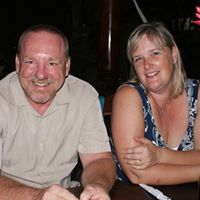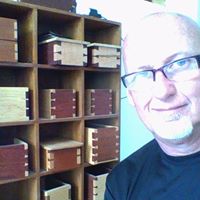Stephen C Goff
age ~69
from Pinellas Park, FL
- Also known as:
-
- Stephen Carlton Goff
- Stephen I Goff
- Steve Goff
Stephen Goff Phones & Addresses
- Pinellas Park, FL
- Plano, TX
- New York, NY
- Seattle, WA
- Moscow, ID
- Newport Beach, CA
- 4540 45Th Ave SW APT 306, Seattle, WA 98116
Vehicle Records
-
Stephen Goff
view source -
Address:7801 Constitution Dr, Plano, TX 75025
-
VIN:KNDJT2A29B7736520
-
Make:KIA
-
Model:SOUL
-
Year:2011
Us Patents
-
Retroviral Packaging Cell Lines And Processes Of Using Same
view source -
US Patent:6372502, Apr 16, 2002
-
Filed:Nov 17, 1994
-
Appl. No.:08/341269
-
Inventors:Arthur Bank - Riverdale NY
Dina G. Markowitz - New York NY
Stephen P. Goff - Tenafly NJ -
Assignee:The Trustees of Columbia University in the City of New York - New York NY
-
International Classification:C12N 1587
-
US Classification:435465, 435455, 435325, 435354, 435357
-
Abstract:This invention provides a mammalian cell useful for retroviral packaging comprising two plasmids, both of which comprise the 5â long terminal repeat (LTR) sequence from a helper virus, neither of which comprise a functional packaging sequence or a 3â LTR from the helper virus, one of which comprises the env gene from the helper virus and the other of which comprises the gag and pol genes from the helper virus. This invention also provides a process for preparing a producer cell useful for transferring a foreign gene into a mammalian cell which comprises treating the above-described mammalian cell with a vector plasmid so as to insert the vector plasmid into the cell and thus create the producer cell, the vector plasmid comprising the foreign gene, a functional packaging sequence from the helper virus, both the 5â and 3â LTRS from the helper virus, and a gene encoding a selectable or identifiable phenotypic trait, and recovering the producer cell so created.
-
Eip-1 And Eip-3 Genes, Envelope-Interacting Proteins, Eip-1 And Eip-3
view source -
US Patent:6469153, Oct 22, 2002
-
Filed:May 20, 1998
-
Appl. No.:09/082358
-
Inventors:Stephen P. Goff - Tenafly NJ
Xingqiang Li - Chestnut Hill MA -
Assignee:The Trustees of Columbia University in the City of New York - New York NY
-
International Classification:C07H 2104
-
US Classification:536 235, 4353201, 435 691
-
Abstract:This invention provides isolated nucleic acid molecules encoding envelope-interacting protein-1 and envelope-interacting protein-3. This invention provides fusion proteins comprising EIP-1, EIP-3, or fragments thereof and a second peptide. This invention provides vectors comprising the isolated nucleic acid molecule, encoding mammalian EIP-1 and EIP-3. This invention provides plasmid designated pCGN-EIP-l and pCGN-EIP-3. This invention provides purified mammalian EIP-1 and EIP-3 proteins. This invention provides monoclonal or polyclonal antibodies directed to epitopes of an EIP-1 or an EIP-3. This invention provides a method of increasing transduction efficieny of a retrovirus on target cells comprising: a) incubating an envelope-interacting protein with a retrovirus; and b) transducing the target cells with the retrovirus. This invention provide methods of treating patient with a therapeutic gene comprising use of transducing viruses incubated with an effective amount of an envelope-interacting protein effective to enhance retroviral infectivity. This invention also provides pharmaceutical composition comprising an envelope-interacting protein bound retroviral virion comprising a therapeutic gene and a pharmaceutically acceptable carrier capable of passing through a cell membrane.
-
Two Hybrid Assay That Detects Hiv-1 Reverse Transcriptase Dimerization
view source -
US Patent:6812025, Nov 2, 2004
-
Filed:Jun 12, 2002
-
Appl. No.:10/009433
-
Inventors:Stephen P. Goff - Tenafly NJ
Gilda Tachedjian - New York NY -
Assignee:The Trustees of Columbia University in the City of New York - New York NY
-
International Classification:C12N 516
-
US Classification:4353391, 435 5, 435 6, 435 697
-
Abstract:This invention provides methods of determining whether a compound inhibits HIV-1 reverse transcriptase. This invention provides methods of determining whether a compound inhibits formation of a complex between a p66 and p51 subunit polypeptides of HIV-1 reverse transcriptase. This invention provides a method of determining whether a compound enhances formation of a complex between a p66 and p51 subunit polypeptides of HIV-1 reverse transcriptase. This invention provides methods of determining whether a compound inhibits formation of a complex between two p66 subunit polypeptides of HIV-1 reverse transcriptase. This invention provides methods of determining whether a compound enhances formation of a complex between two p66 subunit polypeptides of HIV-1 reverse transcriptase.
-
Two-Hybrid Assay That Detects Hiv-1 Reverse Transcriptase Dimerization
view source -
US Patent:20030007983, Jan 9, 2003
-
Filed:Dec 6, 2001
-
Appl. No.:10/006626
-
Inventors:Stephen Goff - Tenafly NJ, US
Gilda Tachedjian - East Malvern, AU
Bryan O'Hara - Norwood NJ, US -
International Classification:C12Q001/70
C12P021/06
C12P019/34
A61K039/00
A61K039/38
A61K039/21 -
US Classification:424/208100, 424/207100, 424/184100, 435/005000, 435/091100, 435/069100
-
Abstract:This invention provides methods of determining whether a compound inhibits HIV-1 reverse transcriptase. This invention provides methods of determining whether a compound inhibits formation of a complex between a p66 and p51 subunit polypeptides of HIV-1 reverse transcriptase. This invention provides a method of determining whether a compound enhances formation of a complex between a p66 and p51 subunit polypeptides of HIV-1 reverse transcriptase. This invention provides methods of determining whether a compound inhibits formation of a complex between two p66 subunit polypeptides of HIV-1 reverse transcriptase. This invention provides methods of determining whether a compound enhances formation of a complex between two p66 subunit polypeptides of HIV-1 reverse transcriptase.
-
Zap Protein And Related Compositions And Methods
view source -
US Patent:20070025967, Feb 1, 2007
-
Filed:Aug 12, 2004
-
Appl. No.:10/568396
-
Inventors:Stephen Goff - Tenafly NJ, US
Guanxia Gao - Beijing, CN -
International Classification:A61K 48/00
A61K 38/48
C12Q 1/70
C12Q 1/68
C07H 21/04
C12P 21/06
C12N 9/12 -
US Classification:424093200, 435006000, 435069100, 435194000, 435320100, 435325000, 424094500, 536023200, 435005000
-
Abstract:This invention provides an isolated ZAP protein and methods and articles of manufacture for increasing resistance to a virus in a subject or mammalian cell. The instant methods and articles are based on the use the ZAP protein to increase such resistance to a virus.
-
Retroviral Packaging Cell Lines And Process Of Using Same
view source -
US Patent:52780562, Jan 11, 1994
-
Filed:Apr 29, 1992
-
Appl. No.:7/877269
-
Inventors:Arthur Bank - Riverdale NY
Dina G. Markowitz - New York NY
Stephen P. Goff - Tenafly NJ -
Assignee:The Trustees of Columbia University in the City of New York - New York NY
-
International Classification:C12N 506
C12N 1586 -
US Classification:4351723
-
Abstract:The invention relates to a mammalian cell line useful for retroviral packaging comprising two plasmids, the first such plasmid comprising in 5' to 3' order: a DNA sequence comprising a 5' long terminal repeat (LTR); a mutated. psi. packaging sequence; a DNA sequence comprising the encoding portion of the Moloney murine leukemia virus (MULV) env gene; and the second such plasmid comprising in 5' to 3' order: a DNA sequence comprising a 5' long terminal repeat (LTR); a mutated. psi. packaging sequence; a DNA sequence comprising the encoding portion of the Moloney murine leukemia virus (MULV) gag and pol genes; a selectable marker; and an origin of replication. The invention also relates to processes for preparing a producer cell line useful for transferring a gene of interest into recipient mammalian cells in vitro.
-
Expression Of Human Immunodeficiency Virus (Hiv) Reverse Transcriptase
view source -
US Patent:52565548, Oct 26, 1993
-
Filed:Dec 2, 1991
-
Appl. No.:7/800682
-
Inventors:Stephen P. Goff - Tenafly NJ
Naoko Tanese - New York NY
William A. Haseltine - Cambridge MA -
Assignee:The Trustees of Columbia University in the City of New York - New York NY
The Dana Farber Cancer Institute - Boston MA -
International Classification:C12N 900
C12N 1549 -
US Classification:435183
-
Abstract:This invention describes pHRT25, a plasmid containing a modified pol gene of the Human Immunodeficiency Virus Type 1 (HIV-1), formerly HTLV-III, under control of an inducible trp promoter. Methods of expressing reverse transcriptase activity using pHRT25 in E. coli are described.
-
Expression Of Human Immunodeficiency Virus (Hiv) Reverse Transcriptase
view source -
US Patent:52022595, Apr 13, 1993
-
Filed:Dec 28, 1988
-
Appl. No.:7/291125
-
Inventors:Stephen P. Goff - Tenafly NJ
Naoko Tanese - Berkeley CA -
Assignee:The Trustees of Columbia University in the City of New York - New York NY
-
International Classification:C12N 121
C12N 912
C12N 1510 -
US Classification:43525233
-
Abstract:This invention provides a plasmid identified as pHRTRX2 and deposited in E. coli HB101 under ATCC Accession No. 67828. The invention also provides for a polypeptide having HIV reverse transcriptase activity and for a method by which the polypeptide can be prepared which comprises growing a host cell comprising the plasmid pHRTRX2 under suitable conditions permitting production of the polypeptide and recovering the resulting polypeptide.
Resumes

Project Manager At Banctec, Inc.
view sourceLocation:
Dallas/Fort Worth Area
Industry:
Computer Software

Business Analyst
view sourceLocation:
Dallas, TX
Industry:
Information Technology And Services
Work:
Genesis10
Business Analyst
Entelli Consulting Jun 2015 - Dec 2016
Consultant
Bank of America Nov 2012 - Feb 2015
Business Support and Resource and Release Manager
Bank of America Nov 2010 - Oct 2012
Service Delivery Consultant
Bank of America Apr 2006 - Oct 2010
Business Analyst and Developer and Project Manager
Business Analyst
Entelli Consulting Jun 2015 - Dec 2016
Consultant
Bank of America Nov 2012 - Feb 2015
Business Support and Resource and Release Manager
Bank of America Nov 2010 - Oct 2012
Service Delivery Consultant
Bank of America Apr 2006 - Oct 2010
Business Analyst and Developer and Project Manager
Education:
University of Idaho
Bachelors, Bachelor of Science
Bachelors, Bachelor of Science
Skills:
Integration
Sdlc
Project Management
Enterprise Architecture
Business Analysis
It Strategy
Vendor Management
Leadership
Software Project Management
Requirements Analysis
It Management
Pmo
Program Management
Business Intelligence
Project Portfolio Management
Management
Software Development
Process Improvement
Requirements Gathering
Visio
Enterprise Software
Risk Management
Software Development Life Cycle
Sdlc
Project Management
Enterprise Architecture
Business Analysis
It Strategy
Vendor Management
Leadership
Software Project Management
Requirements Analysis
It Management
Pmo
Program Management
Business Intelligence
Project Portfolio Management
Management
Software Development
Process Improvement
Requirements Gathering
Visio
Enterprise Software
Risk Management
Software Development Life Cycle
Certifications:
Insights From A Business Analyst
Business Analysis Foundations
Business Analysis Foundations

Stephen Goff
view source
Stephen Goff
view source
Stephen Goff
view source
Stephen Goff
view source
Stephen Goff
view sourceWork:
Dla Piper
Partner
Partner
Isbn (Books And Publications)

Mechanisms of Cellular Transformation by Carcinogenic Agents
view sourceAuthor
Stephen P. Goff
ISBN #
0080342043


Name / Title
Company / Classification
Phones & Addresses
Director, Director , Vice President
INDEPENDENCE HILL HOMEOWNERS ALLIANCE
3137 Freedom Ln, Plano, TX 75025
3113 Freedom Ln, Plano, TX 75025
7801 Constitution Dr, Plano, TX 75025
3113 Freedom Ln, Plano, TX 75025
7801 Constitution Dr, Plano, TX 75025
Director
Bill's Tax Service, Inc
Classmates

Stephen Goff
view sourceSchools:
Rustburg High School Rustburg VA 1987-1991
Community:
Jenny Paulhus, Elaine Spradlin, Socorro Escobedo

Stephen Goff
view sourceSchools:
Little Cypress-Mauricevi High School Orange TX 2004-2008
Community:
Thomas Teal, Shirlee Pearson

Stephen Goff
view sourceSchools:
Berkley High School Berkley MI 1966-1970
Community:
Christine Palmer, Joan Smith

Stephen Goff
view sourceSchools:
Knox County Joint Vocational High School Mt. Vernon OH 1971-1973
Community:
Terry Ferris

Stephen Goff
view sourceSchools:
Gordon School East Providence RI 1957-1962, Providence Country Day School East Providence RI 1962-1969
Community:
Frederick Thurber, Michele Brugnoni, Laurence Poulin, George Bradley, Lawrence Celani, Robert George, Greg Anthony, Thomas Rose, William Muenchinger, Edward Foss, John Dorcus

Stephen Goff
view sourceSchools:
Gordon School East Providence RI 1957-1962, Providence Country Day School East Providence RI 1962-1969
Community:
Stephen Goff, Frederick Thurber, Laurence Poulin, George Bradley, Lawrence Celani, Robert George, Greg Anthony, Thomas Rose, William Muenchinger, Edward Foss, John Dorcus

Stephen Goff
view sourceSchools:
Forest Grove High School Forest Grove OR 1973-1977
Community:
Deborah Somfleth, Angela Papadopoli

Providence Country Day Sc...
view sourceGraduates:
Stephen Cardi (1996-2000),
Stephen Heard (1962-1966),
Stephen Goff (1962-1969),
Herman Munster (1985-1989)
Stephen Heard (1962-1966),
Stephen Goff (1962-1969),
Herman Munster (1985-1989)
Myspace
News

The Shellfish Gene
view source- struggled to work out what was causing the cancer. But once they noticed that the disease seemed to spread from infected clams to uninfected ones, they suspected that a virus might be involved. Thats when Stephen Goff from Columbia University, who studies viruses that cause leukemia in mice, got a call.
- Date: Apr 16, 2018
- Category: Health
- Source: Google

Scientists just doubled the number of known contagious cancers
view source- But when molecular biologist Stephen Goff biopsiedthese mussels, he found something strange. The tumorcells didn't have the same DNA as their host. Instead, every mussel was being killed by the same line of cancerous cells, which were jumping from one individual to the next like a virus. The musse
- Date: Jun 22, 2016
- Category: Health
- Source: Google

Clam Cancer Spreads Along Eastern Seaboard
view source- You might be surprised to hear that clams can get blood cancer. "But the fact is they have a circulatory system, and they can get leukemia," says Stephen Goff, a Howard Hughes Medical Institute investigator at Columbia University.
- Date: Apr 10, 2015
- Category: Health
- Source: Google

Contagious cancer killing East Coast clams
view source- "The evidence indicates that the tumor cells themselves are contagious -- that the cells can spread from one animal to another in the ocean," said researcher Stephen Goff of the Howard Hughes Medical Institute and Columbia University in New York City.
- Date: Apr 09, 2015
- Category: Health
- Source: Google

What cancer in clams might tell us about cancer in humans
view source- "It was really wild," said Stephen Goff, a Columbia microbiology and biochemistry professor and one of the authors behind the findings, published Thursday in the journal Cell. "It was not what we were expecting."
- Date: Apr 09, 2015
- Category: Health
- Source: Google

What Is Next For Astros Under Crane?
view source- Per The Examiners Stephen Goff, Wade hadnt met Crane until yesterdays press conference. Not exactly a great sign for his continued employment. Wade believes that if the sale is approved before the trade deadline, it could have a drastic effect on how the club approaches things. I would assume tha
- Date: May 17, 2011
- Category: Sports
- Source: Google

Stephen Michael Goff
view source
Paul Stephen Goff
view source
Stephen James Goff
view source
Stephen R Goff
view source
Stephen C. Goff
view source
Stephen M Goff
view source
Stephen Goff
view source
Stephen Goff
view sourceGoogleplus

Stephen Goff

Stephen Goff

Stephen Goff
About:
Vitamins for Life - providing health solutions from top pharmaceutical grade suppliers and manufacturers.

Stephen Goff

Stephen Goff
Flickr
Youtube
Get Report for Stephen C Goff from Pinellas Park, FL, age ~69



















